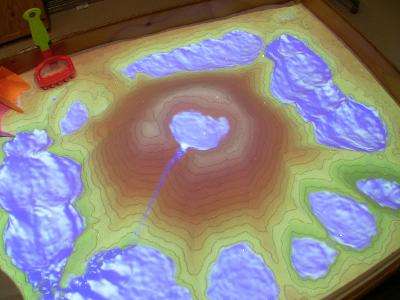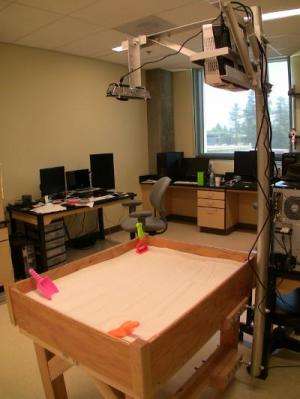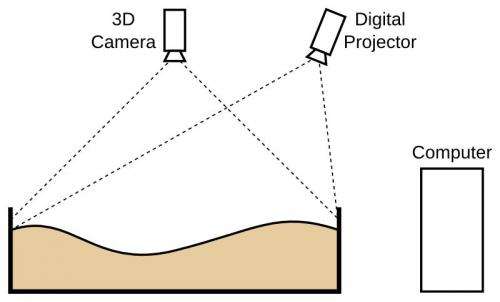May 11, 2012 report
University research team creates augmented reality sandbox (w/ Video)

(Phys.org) -- Most children at some point in their schooling are taught about the water table and many wind up being tasked with creating a model of some sort to represent how it all works. Some use clay, but many more likely use sand, as it’s far easier and faster than most anything else. Now researchers at UC Davis have taken that model to new extremes by building a sandbox system that is capable of automatically adding augmented reality real-time coloring to the sand to indicate altitude and moving water as changes are made to the terrain with a hand or small tool.
The project is part of the University’s Keck Center for Active Visualization in the Earth Sciences (funded by a National Science Foundation grant) and was started as a means of building an educational system for children to help kids better visualize how land and water systems work.
To make the sandbox, the team combined a Kinect 3D camera, a digital projector and simulation software running on a computer and of course, an ordinary sandbox raised up on four legs for optimal viewing.
The system works by first collecting images of the sandbox from above using the Kinect camera, at thirty frames per second, as a demonstrator (or student) changes the landscape below in the sandbox. Information from the camera is fed to a computer running the simulation software (Vrui VR development toolkit). The software generates different colors to represent different elevation levels in a virtual topological map. It also uses a set of Saint-Venant shallow water equations to create realistic looking water movement. Both are then projected down onto the sandbox in real time, giving the appearance of reacting to changes made by a person creating hills, valleys, rivers, streams and lakes in the sand. The result is nearly instant color coding of elevation topography and the instigation of virtual water into the modeled waterways.

What’s even cooler is the fact that the software used to create the simulations is all available under a GNU public license agreement, which means most any school, museum or other teaching program could build a similar system at very little cost. With such a system, students can gain a deeper understanding of how land and water systems interact and see for themselves how changes to topography over time cause changes in the environment in a much more hands-on fashion than when building static models out of sand, dirt or clay.

More information: Project page idav.ucdavis.edu/~okreylos/ResDev/SARndbox/
© 2012 Phys.Org

















